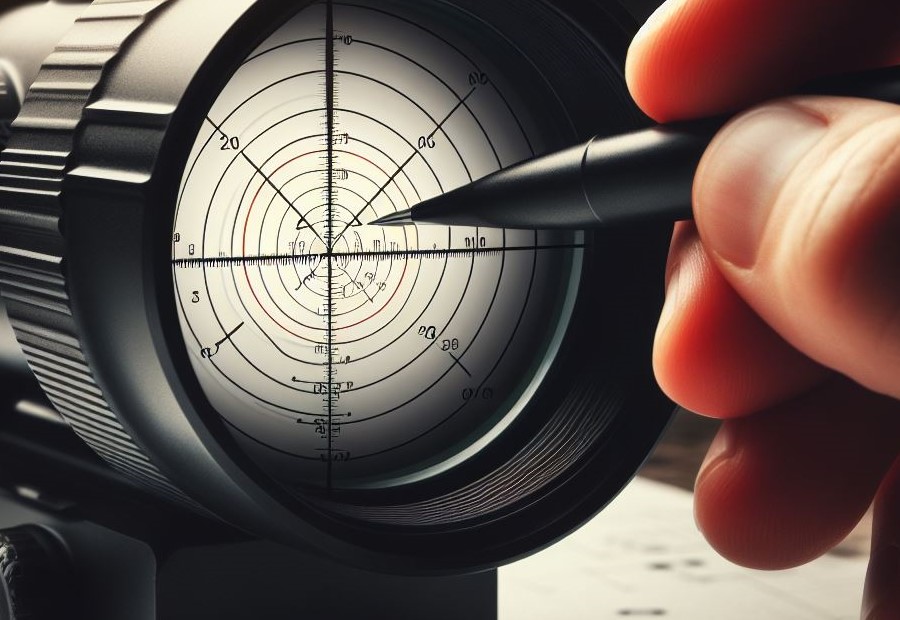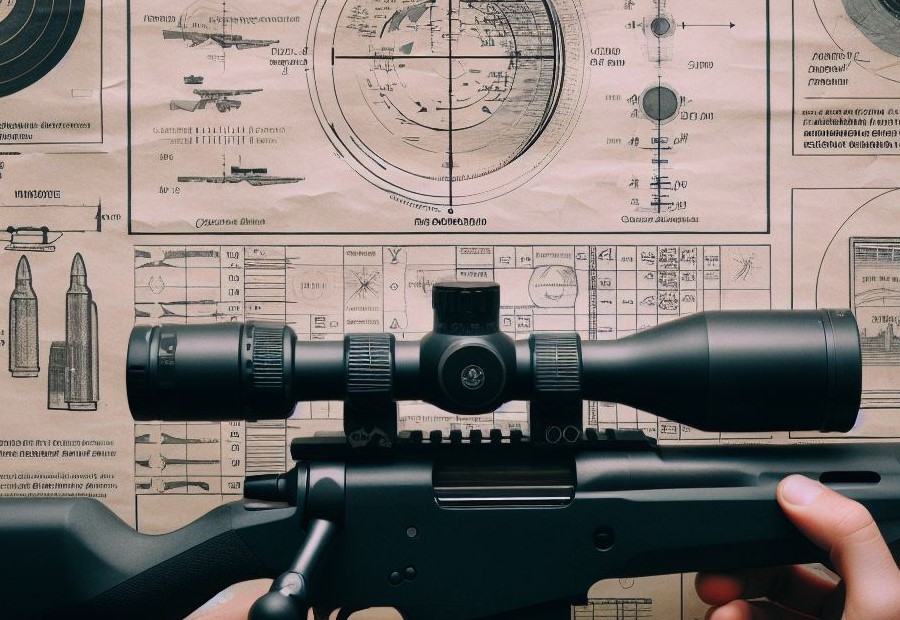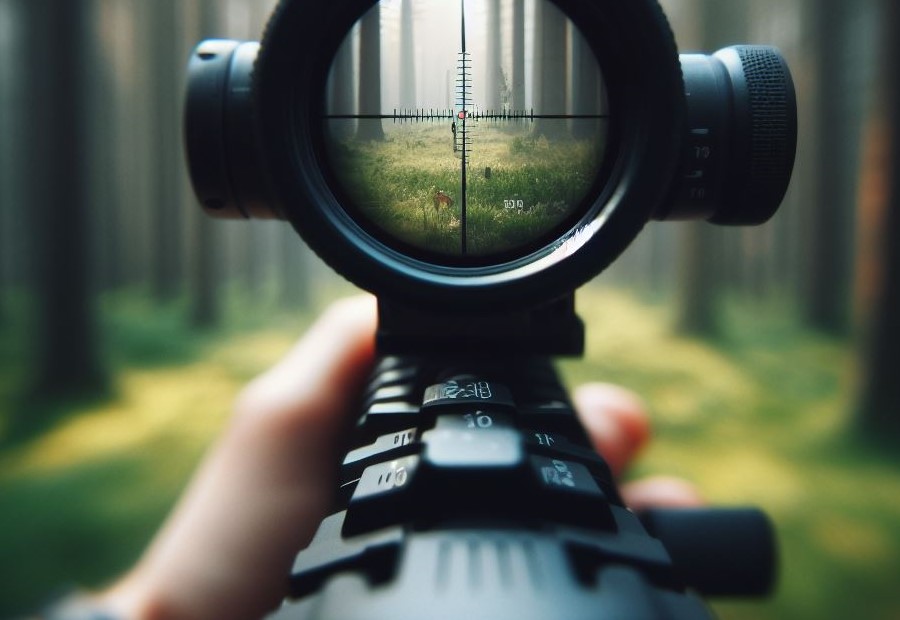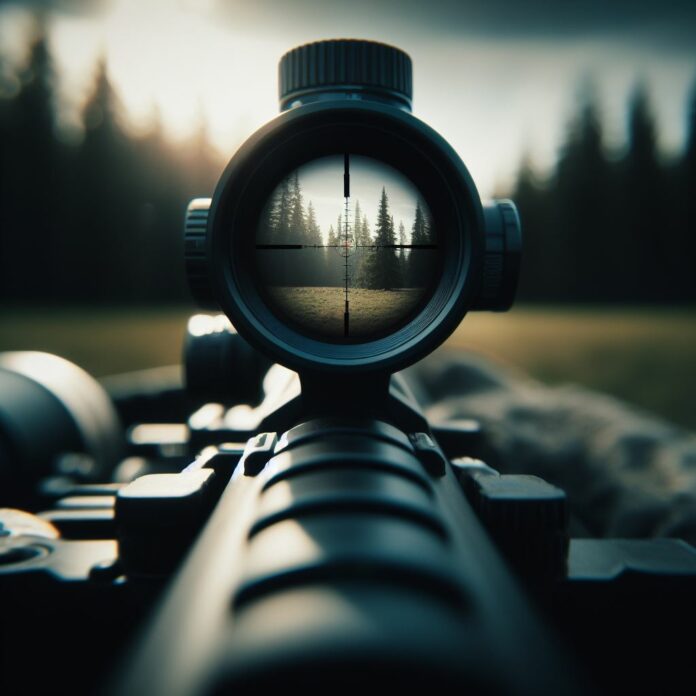A mil-dot scope is a specialized sighting system that allows shooters to accurately estimate range, adjust for bullet drop and windage, and make precise shots. Understanding how to use a mil-dot scope is essential for long-range shooting enthusiasts and professional marksmen.
Firstly, it’s crucial to understand what a mil-dot scope is and how its reticles function. The mil-dot reticle consists of small dots or hash marks spaced at specific intervals in the scope’s crosshairs. These dots serve multiple purposes, such as estimating range, compensating for bullet drop, and calculating windage.
To use a mil-dot scope effectively, you need to learn how to zero your scope and estimate range accurately. Zeroing ensures that your scope is calibrated to your firearm, ensuring precise shots.
Estimating range involves using the mil-dots as references to determine the distance between you and your target. This can be achieved through using the mil-dot formula or the known target size method.
Once you have estimated range, you can adjust for bullet drop and windage. This can be done using the mil-dot holdover method, where you use the mil-dots to make elevation and windage adjustments.
Alternatively, you can make adjustments using the turret adjustment method, which entails adjusting the scope’s elevation and windage dials.
When using a mil-dot scope, it is essential to practice estimating range, consider environmental factors such as wind and other variables that may affect bullet trajectory, familiarize yourself with your scope’s reticle, and use the correct magnification for the given situation.
By mastering the techniques and incorporating best practices for using a mil-dot scope, shooters can greatly enhance their shooting precision and accuracy.
Whether you are a hunter, competitive shooter, or a tactical marksman, understanding how to use a mil-dot scope is a valuable skill that can elevate your shooting performance.
What is a Mil-Dot Scope?

A Mil-Dot scope, also known as a milliradian scope, is a specialized type of rifle scope designed for range estimation and bullet drop compensation. It features a unique reticle with evenly spaced small dots along the crosshairs.
Each dot corresponds to a specific distance, typically one mil (or milliradian). With the Mil-Dot scope, you can accurately determine the distance to a target by measuring the size of an object within the scope and knowing its actual size.
This scope proves extremely valuable in various shooting scenarios. Whether you need to assess the distance to a target or adjust your aim to counteract bullet drop at different distances, the Mil-Dot scope comes to your aid.
Additionally, it extends its functionality beyond range estimation and bullet drop compensation. Military snipers and long-range shooters also utilize Mil-Dot scopes for windage correction and target holdovers.
Incorporating the knowledge of how to effectively use a Mil-Dot scope ensures a significant enhancement in shooting accuracy and precision.
Understanding Mil-Dot Reticles

Understanding Mil-Dot Reticles is crucial for effectively using a mil-dot scope. These reticles consist of dots spaced at specific intervals, allowing shooters to estimate the distance to their target.
The dots can also be used for windage and elevation adjustments. To understand mil-dot reticles, it’s important to know that one mil represents one yard at a distance of 1,000 yards.
By using the mil-dot formula and knowing the size of the target, you can calculate the distance. By practicing with different targets and distances, you can become proficient in using mil-dot reticles and make accurate shots.
Remember to account for any changes in weather conditions or target size that may affect your calculations. By mastering mil-dot reticles, you can enhance your shooting skills and improve your accuracy in different scenarios.
Suggestions for understanding mil-dot reticles:
- Familiarize yourself with the mil-dot formula and how to calculate target distance.
- Practice using mil-dot reticles at varying distances and target sizes to improve accuracy.
- Consider attending a training course or seeking guidance from experienced shooters to enhance your understanding.
- Keep track of adjustments and conditions for future reference and learning.
- Regularly review and refine your skills to maintain proficiency with mil-dot reticles.
What are Mil-Dots?
To understand What are Mil-Dots?, consider the following:
- Mil-dots are small dots or markings on the reticle of a mil-dot scope.
- They are generally spaced at intervals of 1 milliradian (mil) and are used for various purposes.
- The primary purpose of mil-dots is to assist with estimating range to a target.
- By measuring the size of an object in mils using the mil-dots, you can calculate the distance to the target.
- Mil-dots can also be used to adjust for bullet drop and windage.
How are Mil-Dots Measured?
Mil-dots are measured using a specific unit called the milliradian (mrad).
Here is a step-by-step guide on how mil-dots are measured:
- Start by understanding that a mil-dot reticle has a specific mil-dot spacing. This spacing is usually 1 milliradian, or mrad, between each dot.
- To measure the size of an object or the distance to a target, you need to use the mil-dot formula or the known target size method.
- Using the mil-dot formula, you can calculate the range by measuring the size of the target in mils and multiplying it by a constant. This constant differs depending on the scope and magnification used.
- If you know the size of the target, you can use the known target size method. Measure the size of the target in mils using the mil-dot reticle, and then refer to a chart or table that correlates mils to distances. This will give you an estimation of the target’s range.
- Once you have the range, you can adjust for bullet drop and windage using the mil-dot holdover method or the turret adjustment method. The mil-dot holdover method involves using the mil-dots as reference points to hold higher or lower when aiming. The turret adjustment method involves using the elevation and windage turrets on the scope to make precise adjustments.
Pro tip: Practice estimating range using mil-dots in various scenarios to become familiar with the measurements and improve your accuracy in the field.
What is the Purpose of Mil-Dots?
The purpose of mil-dots is to provide a measurement system that enables shooters to estimate the distance to a target and make necessary adjustments to hit the target accurately.
Mil-dots are tiny dots or hash marks that are evenly spaced along the reticle of a mil-dot scope, typically placed at intervals of one milliradian (mil).
The main purpose of mil-dots is to help shooters estimate range. By using the mil-dots in conjunction with the known size of the target or the mil-dot formula, shooters can calculate the distance to the target.
This is crucial for making accurate adjustments for bullet drop and windage.
Mil-dots also allow for quick and easy reference when adjusting for bullet drop and windage. By using the mil-dot holdover method or the turret adjustment method, shooters can compensate for these factors and ensure that their shots hit the target.
In addition to range estimation and adjustments, mil-dots serve the purpose of helping shooters become more proficient and accurate over time.
By practicing estimating range and familiarizing themselves with their scope’s reticle, shooters can cultivate their skills and improve their overall shooting performance.
How to Use a Mil-Dot Scope?

Unlock the full potential of your mil-dot scope with these essential techniques! Discover the art of zeroing your scope to achieve pinpoint accuracy.
Learn how to estimate range with precision and make adjustments for bullet drop and windage like a seasoned marksman. It’s time to take your shooting skills to the next level and dominate the field with confidence.
Let’s dive right into these game-changing mil-dot scope strategies and become a force to be reckoned with!
Zeroing Your Scope
When zeroing your scope, follow these steps to ensure accuracy:
- Choose a stable shooting position and secure your rifle.
- Aim at your target and fire a shot.
- Examine where the bullet landed in relation to your aiming point.
- If the bullet hit higher than your target, adjust the elevation turret on your scope in the downward direction.
- If the bullet hit lower than your target, adjust the elevation turret on your scope in the upward direction.
- If the bullet hit to the left of your target, adjust the windage turret on your scope to the right.
- If the bullet hit to the right of your target, adjust the windage turret on your scope to the left.
- Repeat steps 2-7 until your bullets consistently hit the desired spot.
- Confirm your zero by shooting multiple rounds and verifying their accuracy.
- Keep track of your scope’s adjustments and any necessary holdover or windage adjustments for future reference.
Remember, zeroing your scope is essential for precise shooting. It ensures that your rifle is accurately calibrated to hit your desired target.
Estimating Range
To estimate range using a Mil-Dot scope, follow these steps:
- Ensure your scope is properly zeroed.
- Use the Mil-Dot formula to estimate range. Measure the size of the target in mils using the Mil-Dots in your scope. Divide the size of the target in inches by the size of the target in mils to get the range in yards. For example, if the target measures 18 inches and it covers 3 mils, the formula would be: 18 inches / 3 mils = 6 yards.
- If you don’t know the size of the target, you can use the known target size method. This method relies on knowing the approximate size of common objects and their corresponding mil measurements. By comparing the size of the target in your scope to the known mil measurement of an object, you can estimate the range.
- Adjust for bullet drop and windage. Use the Mil-Dot holdover method to adjust for bullet drop. Estimate the distance between your zero and the target in mils and use that to hold over or under your reticle. To adjust for windage, use the turret adjustment method. For every 1 mph of wind, adjust your turret based on the mil values provided by the manufacturer.
By following these steps, you can effectively estimate the range using a Mil-Dot scope. Remember to practice and familiarize yourself with your scope’s reticle for optimal results.
Adjusting for Bullet Drop and Windage
Adjusting for Bullet Drop and Windage can be done by following these steps.
First, calculate bullet drop by using the mil-dot reticle to measure the distance between you and the target. Use the mil-dot formula to estimate the distance based on the size of the target and the number of mils it covers.
Once you know the distance and bullet drop, determine holdover using the mil-dot holdover method. Adjust your aim by keeping the reticle’s center on the target and aligning the appropriate mil-dot with the estimated bullet drop.
Next, you need to account for windage. Estimate the wind speed and direction and use the windage marks on the reticle to compensate for the wind. Hold into the wind by holding off to one side of the target, taking into account the estimated windage in mils.
If your mil-dot scope has turret adjustments, you can use the turret adjustment method to fine-tune your aim.
Adjust the windage and elevation turrets on your scope, which will move the reticle accordingly to compensate for bullet drop and windage.
By following these steps, you can effectively adjust for bullet drop and windage when using a mil-dot scope.
It is important to practice and become familiar with your specific scope to improve accuracy and precision in long-range shooting scenarios.
Tips and Best Practices for Using a Mil-Dot Scope

If you’re looking to master the art of using a mil-dot scope, then you’ve come to the right place.
In this section, we’ll uncover valuable tips and best practices that will enhance your mil-dot scope skills.
From honing your ability to estimate range to considering environmental factors that can impact your shot, we’ll cover it all.
Additionally, we’ll dive into the importance of becoming familiar with your scope’s reticle and the significance of using the correct magnification.
Get ready to take your shooting precision to the next level!
Practice Estimating Range
To practice estimating range using a mil-dot scope, it is important to follow these steps:
1. Start by zeroing your scope. This ensures that the point of impact aligns with the center of the reticle.
2. With the zeroed scope, locate your target and estimate its size or use a known target size method. This will give you a baseline for range estimation.
3. Use the mil-dot formula to estimate the range. This involves counting the number of mil-dots from the center of the reticle to the target and applying the appropriate conversion factor.
4. Alternatively, you can use the known target size method. This involves comparing the size of the target to the mil-dots in the reticle to estimate the range.
5. Adjust for bullet drop and windage by using the mil-dot holdover method. This involves using the mil-dots to compensate for the bullet’s trajectory and wind conditions.
6. You can also adjust for bullet drop and windage by using the turret adjustment method. This involves dialing the elevation and windage adjustments on the scope based on the mil-dot measurements.
Practicing range estimation with a mil-dot scope is crucial for accurate shooting. By following these steps, you can improve your ability to estimate the range of your targets and make precise adjustments for bullet drop and windage.
Consider Environmental Factors

When using a Mil-Dot scope, it is important to consider environmental factors. These factors include weather conditions, lighting conditions, background and terrain, and moving targets.
Weather conditions play a crucial role in bullet trajectory. Factors like wind speed and direction, temperature, humidity, and barometric pressure should be taken into account for accurate shooting.
Lighting conditions also affect your ability to see the Mil-Dots clearly. Adjust the brightness or contrast settings on your scope as needed to ensure a clear sight picture.
The background and terrain where you are shooting can impact the visibility of the target and the ease of estimating range. Consider factors like distance, vegetation, elevation changes, and any other objects that may obstruct your view.
If your target is moving, it is important to consider the speed and direction of movement. Adjust your aim accordingly to compensate for the target’s motion.
It is a known fact that environmental factors can significantly affect shot accuracy. Wind, in particular, can have a major impact on bullet trajectory, necessitating adjustments in aiming to compensate for its effects.
Familiarize Yourself with Your Scope’s Reticle
To become familiar with your scope’s reticle, simply follow these steps:
1. Carefully review the user manual that comes with your scope. It will provide you with detailed information about the design and features of the reticle.
2. Take a look through the scope and carefully observe the markings and symbols on the reticle. Pay close attention to the spacing between the mil-dots as well as any additional lines or hash marks.
3. Take the time to understand the meaning and purpose of each marking on the reticle. This could include mil-dots for estimating range, holdover marks for compensating for bullet drop, or windage marks for making adjustments based on wind conditions.
4. Practice using the reticle in different shooting scenarios. Set up targets at various distances and utilize the mil-dots to estimate range and make necessary adjustments to your aim. This will help you develop a better understanding of how the reticle works.
5. Experiment with different magnification levels on your scope. Adjusting the magnification can alter the size and appearance of the reticle, so it’s important to become familiar with how it looks at different settings.
6. Take your scope to the shooting range and spend time actively using it. The more you practice and become comfortable with the reticle, the more proficient you will become.
7. Regularly clean and maintain your scope to ensure it performs optimally. Keep the lenses clean and inspect the reticle for any damage or alignment issues. By maintaining your scope properly, you’ll ensure its longevity and reliability.
Use the Correct Magnification
When utilizing a mil-dot scope, it is crucial to use the appropriate magnification to ensure precise target acquisition and accurate range estimation.
- Make sure to adjust the magnification settings on your scope according to the specific shooting conditions you are facing.
- Take into consideration the distance between you and your target, as well as the size of the reticle in comparison to the target.
- At higher magnifications, the reticle will cover a smaller area of the target, which facilitates more accurate measurement of the mil-dots and estimation of range.
- Conversely, at lower magnifications, the reticle will cover a larger portion of the target, making it more challenging to effectively utilize the mil-dots for range estimation.
- During practice sessions, try out various magnification settings to find the perfect balance between target visibility and reticle accuracy.
By employing the appropriate magnification, you can ensure precise mil-dot measurements and reliable range estimations, ultimately enhancing your shooting proficiency.
Frequently Asked Questions
How do I use a mil-dot scope for range estimation?
To estimate the range using a mil-dot scope, you need to know the size in inches of your target. Count the number of mil dots the target spans in your scope and use the formula (target size in inches x 27.778) / mil size = yards to target.
For example, if the target is 10 inches tall and takes up 1 mil on the reticle, it is estimated to be about 277.78 yards away.
Can a mil-dot scope be used for bullet drop compensation?
Yes, a mil-dot scope can be used to compensate for bullet drop.
By knowing the ballistics of your rifle and ammunition, you can calculate the amount of drop and the mil adjustment needed. Use the formula: bullet drop / 1 mil size for that distance = mils needed to adjust.
For example, if there is a 73-inch drop at 500 yards and 1 mil equals 18 inches at that distance, the mil adjustment needed is 4.06 mils.
How can a smartphone help with mil-dot scope calculations?
There are smartphone apps available that can calculate hit points on the reticle for you, making mil-dot scope calculations easier and more precise.
These apps can assist with range estimation and bullet drop compensation, providing you with the necessary mil adjustments for accurate shooting.
What is the importance of setting the proper magnification when using a mil-dot scope?
When using a mil-dot scope, it is important to set the scope at the proper magnification for accurate range estimation and mil-dot aiming points.
Most mil-dot scopes are set up to range find at 10X magnification, although some scopes may have a different magnification setting.
By setting the right magnification for each distance, you can have an exact mil-dot aiming point and improve shooting accuracy.
Can mil-dot calculations be used for determining target dimensions?
Yes, mil-dot calculations can be used to determine the dimensions of a target. By multiplying the distance by the number of mils the target spans in your scope, you can estimate the target’s height, width, or overall size.
This can be useful for assessing the size of an observed object without the need for additional equipment or changing the scope settings.
Are mil-dot reticles still relevant with the availability of laser rangefinders?
While laser rangefinders are more commonly used now, mil-dot reticles are still relevant and valuable in the field.
Knowing how to use mil-dots can be helpful in case of equipment failure or simply as an alternative method for range finding and bullet drop compensation.
Mil-dot scopes are versatile tools that can provide quick and accurate information without the need for additional equipment.

